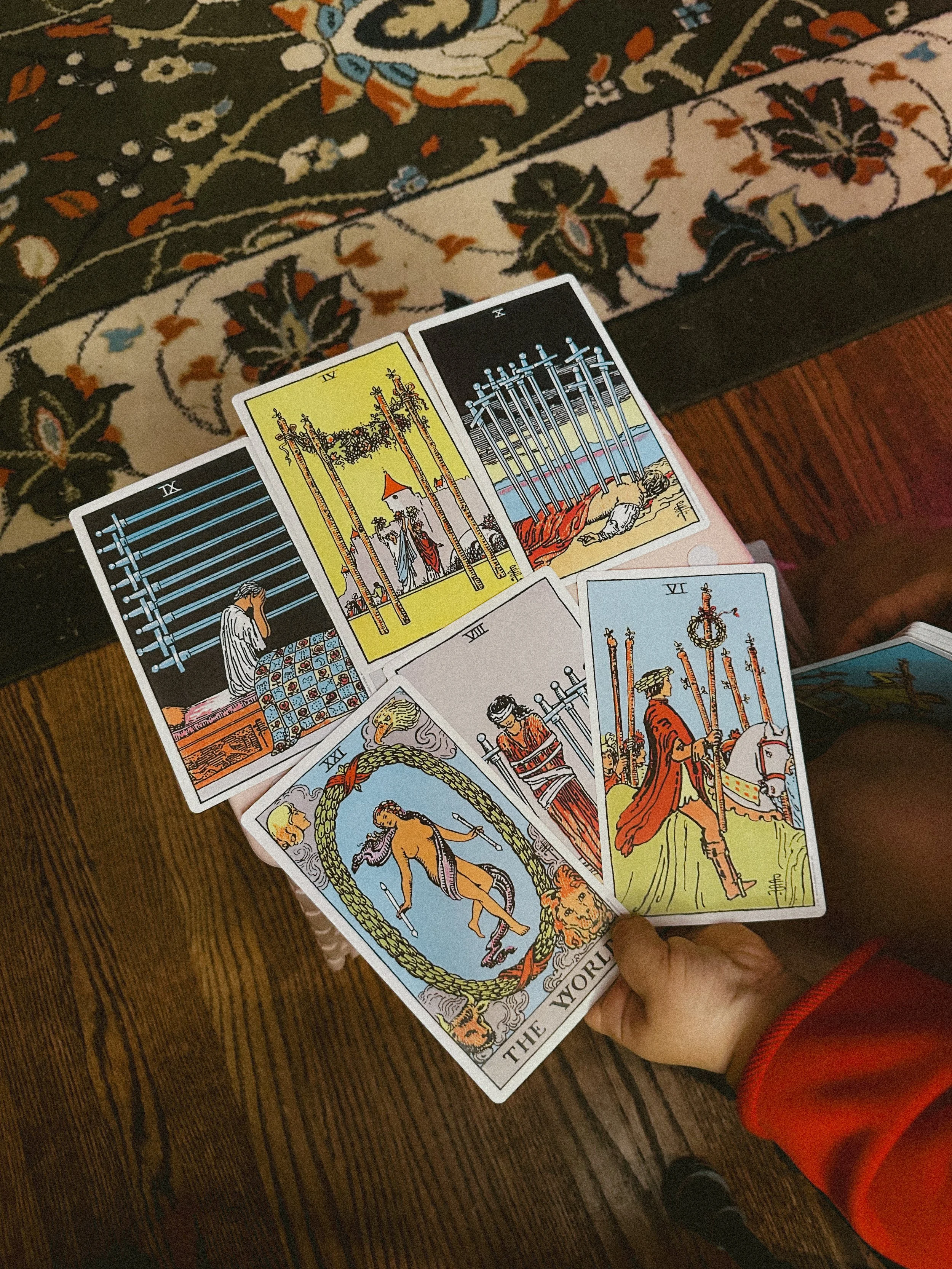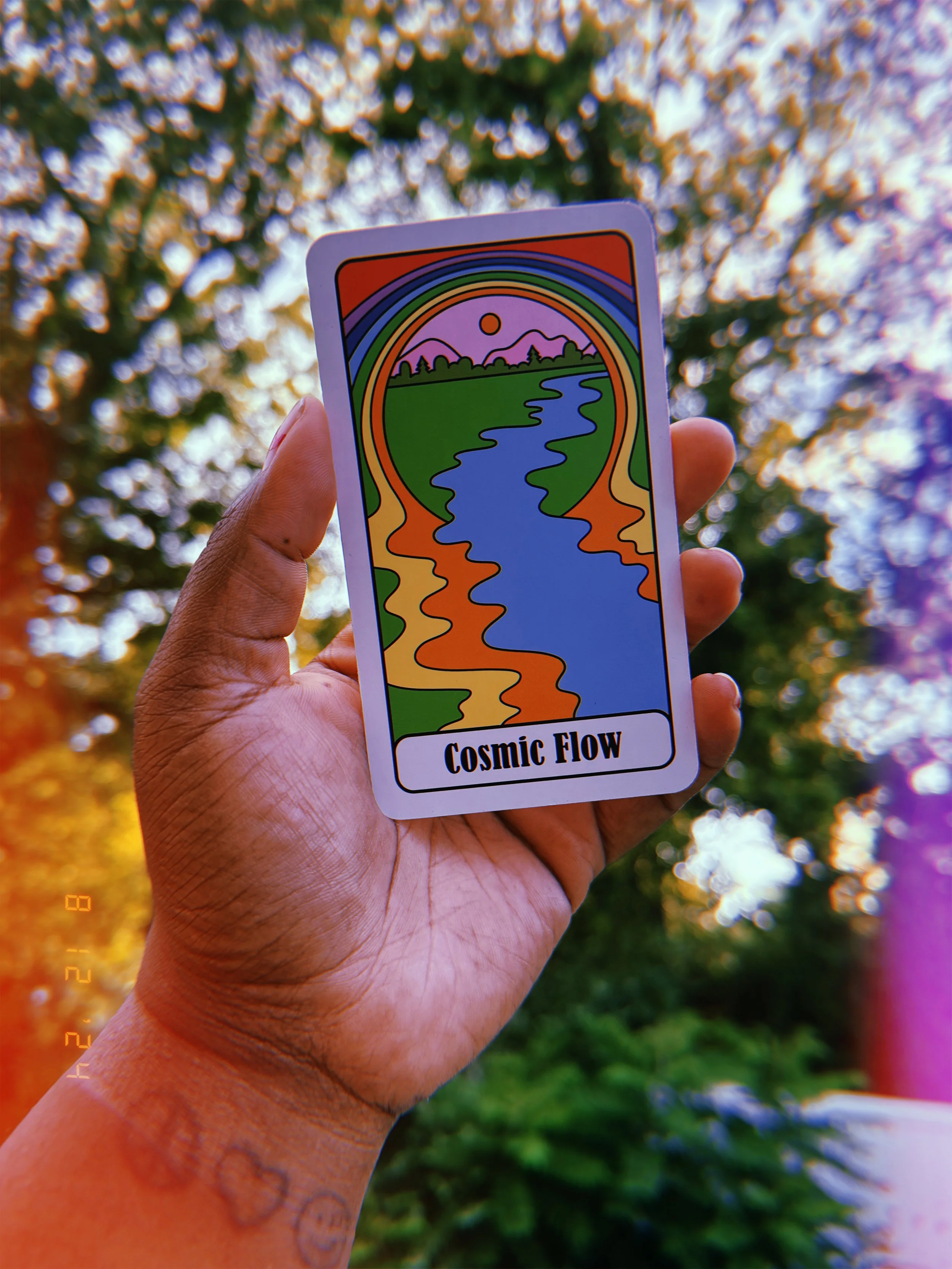TAROT AS A THERAPEUTIC TOOL
I sit down and shuffle my deck.
Immediately there is a sense of calm: the sounds of the cards plucking against each other, the gentle breeze created from the rustling, the smell of a candle nearby, a quiet moment of contemplation.
Intention. This is what is created. A space where I am finally allowed to take up space and self-reflect.
There are so many ways to set intention. Journaling, stretching, walks, breathwork, meditation. For me, tarot contributes to my wellness by allowing space for intentional reflection on life themes, circumstances, and self. There is comfort in processing and deepening exploration of self.
This is where we find ourselves. Sitting together with our decks.
What comes next?
The Intention and The Spread
Begin by setting the intention, which means taking a moment for personal reflection. Notice any felt senses in your body, any thoughts that float to the surface, or ruminations you haven’t been able to release. As you reflect, this is a time to identify what you are seeking, questioning, or exploring. Start by gaining clarity on what you want to ask the deck.
Once this is clear, explore the spread you wish to use as part of your reading. The spread provides a foundation for reading your cards and highlights how cards interact or inform each other. There are many infamous spreads (like the Celtic Cross), and three-card spreads are widely popular and can be adapted to a multitude of situations. You can find spreads in tarot guidebooks, you may use your intuition to create your own, or utilize one of the spreads offered here.
Once you have an intention and spread, begin shuffling the deck and pulling your cards. Personal preference comes into play here; some people shuffle wildly and allow cards to fly out. Others shuffle, cut the deck, and may spread out the cards as a way to pull them. However you decide to choose your cards, once they are pulled you will lay them into your spread and begin your interpretation.
Interpreting your Cards
How you read the cards is a combination of personal experience, intuition, understanding of archetypes, meaning of the artwork, numerology, astrology, the personality of the deck, and much more. It can be intimidating to start, but you are your greatest resource. Many decks come with a guidebook to help you decipher and explore your deck. This can also be a great place to start trusting your own intuition.
Here’s a quick rundown on your deck, which is composed of 78 cards, including the Major Arcana and Minor Arcana:
The Major Arcana
A series of 22 cards which explore a story and journey from The Fool (0) to The World (XXI). The Major Arcana reflects overarching themes that are encountered in life. With this portion of the deck, think big-picture, archetypal, or longer-term ideas.
The Minor Arcana
A series of 56 cards divided into suits of Wands, Cups, Swords, and Pentacles (often associated with fire, water, air, earth). Each suit explores its own journey from Ace to 10, following a pattern of initiation and completion. The Minor Arcana speaks more to situations, specific events, emotions, thoughts, and people.
Speaking of people, each suit also contains Court Cards (Page, Knight, Queen, King). The Court Cards represent specific people or parts of the querent’s own identity and personality.
Now that you know what you’re seeing, here are some insights and questions to guide you in your interpretation.
Take in your first impression
What do you notice about the cards? What do you notice about yourself and how you feel taking in the cards?
Explore Imagery
Do you notice any specific colors, symbols, or motifs standing out to you? Are you drawn to any specific card? Alternately, are you repelled by any of the images?
Identify Cards
Is your spread mostly major or minor arcana cards? Do you have any court cards?
Explore suits and elements
Within the minor arcana cards, are there any patterns around the suits? For example, are your cards mostly pentacles, which represent the element of earth? Or are they swords, indicating air? What do these patterns (or lack of patterns) mean to you?
Explore numbers
Numbers can help us understand where we are in the journey. Do you have several cards that are lower numbers, like The Fool (0) or The Magician (1), or minor cards such as the Ace? These can represent that we are still in the beginning of this journey. What other patterns do you notice?
Cards in the Spread
Note where each card lies in the spread. What relationships show up between the cards? How do they influence each other? Do they reference periods of time (ie past, present, future) and what does this signify to you? Where do you have additional questions? Where are you finding clarity?
Using Tarot to Compliment Therapy
Tarot certainly isn’t a replacement for therapy, but it can be a strong companion to it. Creating intentional time and space to reflect on themes, inner life, and experiences is a mindfulness exercise. If you struggle with journaling, tarot may be a brilliant substitute for you. Additionally, if you are a more visual person, the artwork on the cards may benefit you by providing imagery to reflect upon. Tarot can help provide ways to explore non-tangible experiences and emotions in a more external and tangible way. If you are interested in tarot as a tool to aid your therapeutic journey, consider using it to:
Connect with inner self
Self-reflect
Problem solve
Aid in finding clarity
Contemplate changes
Examine beliefs
So ground into yourself, get curious, and explore what comes up in your next reading. Remember, tarot is not a replacement for therapy, but can be used for personal insight. As a bonus, you can also bring up your readings with your therapist! Processing together can aid in deeper insight.









